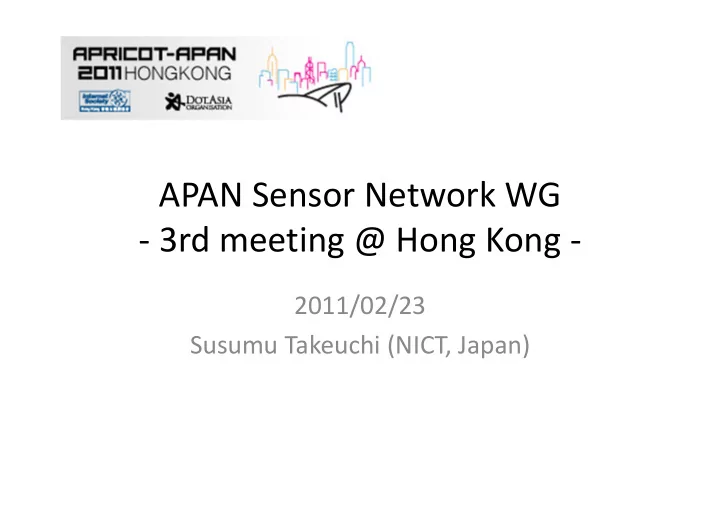

APAN Sensor Network WG ‐ 3rd meeting @ Hong Kong ‐ 2011/02/23 Susumu Takeuchi (NICT, Japan)
Introduction of APAN Sensor Network WG • Chair – Eui ‐ Nam Huh ( KyungHee University, Korea ) • Co ‐ Chairs – Lasse Thiem ( FOKUS, Germany ) – Susumu Takeuchi ( NICT, Japan ) – Basuki Suhardiman ( ITB, Indonesia ) • Secretariat – Reza Khoshdelniat ( MIMOS, Malaysia ) 2
Charter of SensNet WG • Goal – SensNet WG encourages the collaboration of technical experiences and knowledge regarding SNs, and will develop a scalable, sustainable, and easy ‐ to ‐ deploy technical environment for utilizing collected sensing data among SNs deployed in each country. • Objectives – 1. Encourage SN deployment and federation • Exchange SN deployment cases, technical issues and experiences • Standardize SN description (access method/policy, specifications, protocols) and application interface (access method, query language) by utilizing external standards – 2. Federate for sensing data utilization • Develop a federated framework to discovery any resources in heterogeneous SNs for supporting varieties of applications • Ensure the scalability of a federated framework that can handle over millions of sensor nodes for realizing low ‐ cost federation http://www.apan.net/wg/sensor.php 3
Summary of the Past Meetings • 1 st Meeting @ APAN 29 th Sydney (Feb. 2010) – 1 WG Meeting and 2 WS Sessions (w/ 7 speakers) – Introduce our researches and projects • 1 st Core Meeting @ Seoul (May 2010) – Discuss and establish our WG’s formal charter • Updated charter was approved on June • 2 nd Meeting @ APAN 30 th Hanoi (Aug. 2010) – 1 Group Meeting and 2 WS Sessions (w/ 8 speakers) – Share backgrounds to develop our activities 4
Reference: Position Paper • Discussions of the Group Meeting of 2 nd Meeting are published as the position paper – S. Takeuchi, "Activities of APAN Sensor Network WG: Toward a Federated Sensor Network Framework," in Proc. of the APAN 30th Meeting , Nov. 2010. – Available at: http://bit.ly/snpos 5
Objective of the 3rd Meeting • Discuss a concrete approach for a part of the federated framework – Resource Management • Susumu Takeuchi – Data Management • Prof. Eui ‐ Nam Huh • Panel discussion at the next session (afternoon) 6
Goals of the Federated Framework 1. Low ‐ cost and easy deployment and management of sensor networks for wide ‐ area coverage – Deployment cost is a barrier, but management cost is a more critical barrier to maintain sensor networks. 2. Support crucial sensor network applications in the Asia ‐ Pacific region – Environmental monitoring (e.g., weather, disaster, pollution, smart grid) would be essential for sustainable development in this region. 7 Quoted: http://bit.ly/snpos
Grand Design (Conceptual Model) Environment observation Disaster mgmt. e ‐ Agriculture e ‐ Fishery e ‐ Forestry (weather, earth, space) (wildfire, water) Sensor Applications Application interface (query lang., access method, and AAA) Data management (federate independent sensing data) Resource management (access control and resource discovery) Resource desc. Sensor Networks 8 Quoted: http://bit.ly/snpos
Function Blocks and Challenging Issues Application Interface Multiple Overlay Networks Network Management Query Lang. API AAA Data Management Scheme Query Control Storage Aggregation Resource Management Resource Discovery Access Control Description 9 Quoted: http://bit.ly/snpos
Detailed Functions (1/5) • Resource management Resource Management Resource Access Discovery Description p Control – Resource Description • Describe sensors specification that include data type, observation method and interval, access method, data management method, etc. – Discovery • Enable application developers to find an appropriate sensor or data node based on the given sensor ID – Access Control • Handle access for each resource according to its management policy 10 Quoted: http://bit.ly/snpos
Detailed Functions (2/5) Data Management • Data management Scheme Query Control Storage Aggregation – Aggregation • Collect sensing data from sensor node – Storage • Store raw/aggregated sensing data in each data node – Query Control • Retrieve sensing data stored in the data nodes – Scheme • Describe the structure, attributes, relationships, etc. of the stored data 11 Quoted: http://bit.ly/snpos
Discussion and Organization Steps Phase 1: Analyze Requirements (derived from sensor application users and sensor devices inc. already ‐ deployed SN) Phase 2: Grand Design (discuss sustainable architecture and arrange challenging issues) Phase 3: Sub Working Group (each for issues/domains) feedback Metadata/API Resource mgmt. Data mgmt. Etc… Phase 4: Implementation & Deployment (develop federated framework and SNs, deploy, maintain…) * Estimated 4 years to accomplish 12 Quoted: http://bit.ly/snpos
Goals of Today’s Discussion • Discuss issues and exchange related knowledge of the Resource Management and the Data Management field – Requirements each for the management – Related technologies and/or standards – Issues that we should address – Possible contribution for the framework each from organization 13
DISCUSSIONS FOR RESOURCE MANAGEMENT 14
Argument of Resource Management (1) Sensors Specification • Data type (units) – Easy to be converted, but how to describe? • Ex) Temp. = {C, F}, humidity = {RH, AH}, pressure = {alt.} • Observation method, interval, and accuracy – Accuracy = {reaction rate, error rate, etc.} – Different based on device specs. and requirements • Ex) Rain gauge <explained later> • Access method, data management method – I/F and storage policy must be different by domains • Ex) Just collecting by 6LowPAN/ZigBee, or providing by SOAP 15
Ex) Rain Gauge • Tipping bucket rain • Optical rain gauge gauge – Observe real time rain drops by laser – Observe every specified amount of rain Optical Tipping bucket Rain fall 16
Argument of Resource Management (2) Discovery & Access Control • Discovery of sensor/data node – Multiple overlay networks provide a distributed retrieval method • How to allocate sensor ID? • Access control for sensor networks – Handle access each for resource; according to its management policy • How to describe a management policy? • Granularity control must be an unique requirement in sensor networks 17
OPEN DISCUSSION 18
Recommend
More recommend